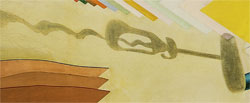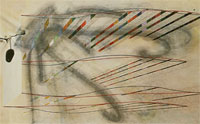|
In 1918 Duchamp produced his last painting Tu m', where he resumes and further elaborates the themes he developed in the meantime in the Large Glass. Inside the painting (which Schwarz, 1974, gives a complete and convincing interpretation) the Stoppages reappear in a new and strange composition, which I shall analyze in this section. At the bottom left corner of the composition, we have a representation of the Stoppages' templates; here it seems that Duchamp wants to play fair: the templates are carefully lined up, in such a manner as to stress their equal length. The Stoppages are directly represented elsewhere in the painting, as we shall see below. However, Duchamp uses only two of the three templates, the first and the last; the central one, not used here, is the same that deceived us in Three Standard Stoppages (perhaps an expiation). A hand painted roughly in the middle of the composition points clearly to the right side, where, at a glance, we immediately recognize the Stoppages; they are newly coupled, and form four pairs: the red Stoppage (corresponding to the lower template) and the black one (upper template). Interestingly, for the two upper pairs (a pair of pairs) the Stoppages have the same orientation, while in the lower pairs (another pair of pairs) the Stoppages have different orientations. Thus, we have a pair of pairs of pairs: a new hint of recursion, even though it returns to base 2. Remember that we already observed the same oscillation between 2 and 3 as the numerical base for the recursion in the notes of the Green Box, where Duchamp projected only 8 (= 23) Malic Moulds (from which 3 Capillaries for each Mould should depart), while the definitive choice will be 9 (= 32, one for each Capillary). But this choice is not definitive, as is testified by the return to the 2 in Tu m'. Let's return to the description of the painting. The Stoppages seem to be freely soaring on the surface of the painting. Some colored rays, irradiating several circumferences, depart perpendicularly from the Stoppages (painted à la Kandinsky, suggests Schwarz). The rays prospectively suggest the dimension of the depth, and they seem vague allusions to evolutes and involutes of a curve that Duchamp could have read in geometry texts. Or, following Henderson the rays with their irradiation could be an allusion to the presence of electricity. In The King and the Queen Surrounded by Swift Nudes (1912) and the Invisible World of Electron she says that
Considering the
depth suggested by the colored rays, our attention is attracted by a
strange, skewed, milk-colored quadrilateral, slightly perceptible relative
to the background with almost the same color. Thus, we notice that the
four pairs of Stoppages start exactly from the four vertexes of the
quadrilateral, perpendicular to it, forming a strange prism in perspective.
The fact that the Stoppages and the quadrilateral must be considered
as a unique object is prospectively stressed by the shared vanishing
point, placed on the lower side of the painting, on the right of the
pointing hand. Hence, Duchamp attracts our attention to the strange
prism (see Fig. 13).
There is an interesting
ambiguity (most likely intentional) in the choice of the representational
system of this strange prism. We already observed its perspective frame
with its vanishing point. Now, according to the rules of perspective,
the farthest Stoppages would be perspectively shortened, but
the Stoppages axiom imposes the rigid conservation of the lengths.
All of this implies an axonometric (and not perspective) vision. As
a consequence, Duchamp doesn't draw (he can't do it) the second face
of the prism (parallel to the milk-colored first one), because this
face would determine a second vanishing point, as showed in Fig.
14.
Hence, the prism is simultaneously depicted by means of both a perspective and axonometric representational system. It therefore delimits an ambiguous space that, furthermore, seems to be closed but is really open. On the other hand, the Stoppages being generalizations of segments and straight lines, it was to be expected that the space delimited by the prism had some generalized properties relative to an ordinary space. But the discovery of the major extraordinary property of this region of the space is due to the fine observation capacity of Gi Lonardini, my wife. To understand it, we must turn our attention to the readymade shadows painted in the composition. Starting from
the left of the painting, we first have the shadow of the Bicycle
wheel (1913) (Fig. 15) (following Schwarz's
interpretation, it would stand for Duchamp). Moving along to the right
we observe the shadow of the Corkscrew (1918)
(Fig. 16) (according to Schwarz, it would be the phallus
of the Bachelor-Duchamp, which desires to consummate the incest with
the Bride, and this would be the meaning of the tear in trompe l'oeil
at the center of the painting). Finally, at the right, the shadow of
the Hat Rack (1917) (Fig. 17) hung
from the ceiling, symbolizes the hanging as punishment for the incest
(again according to Schwarz). >>Next Figs.
13-17
page 1 2 3 4 5 6 7 8 9 10 11 12 13 14 15 |

















